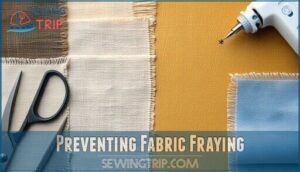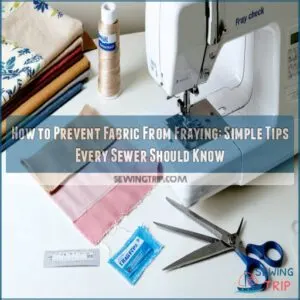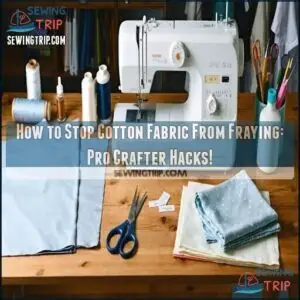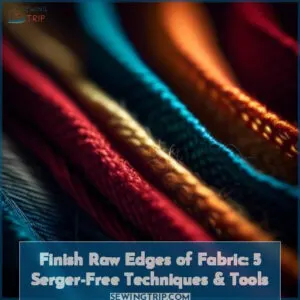This site is supported by our readers. We may earn a commission, at no cost to you, if you purchase through links.
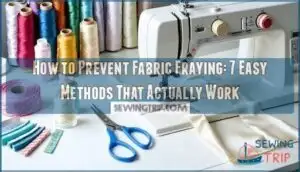 You can prevent fabric fraying using several simple techniques.
You can prevent fabric fraying using several simple techniques.
Apply clear nail polish or fabric sealant directly to cut edges for a quick no-sew fix. For sewing projects, use a zigzag stitch or serger to overcast raw edges before construction.
Pinking shears create a sawtooth edge that naturally resists unraveling. French seams enclose raw edges completely within the seam itself.
For delicate fabrics, try binding edges with bias tape or using a liquid fray preventer that dries clear. The key is matching your prevention method to your fabric type and project requirements.
Each technique offers different advantages depending on whether you’re dealing with heavyweight canvas or delicate silk, and using the right method is crucial for a successful project with delicate silk or other fabrics.
Table Of Contents
Key Takeaways
- Choose the right prevention method for your fabric type – Match techniques to material density, since loose weaves, like burlap, need stronger solutions, like liquid sealants, while tightly woven fabrics work well with simple zigzag stitching or pinking shears.
- Apply preventive measures immediately after cutting – Seal raw edges with Fray Check, clear nail polish, or fabric sealant right away to create a protective barrier before fibers start loosening and unraveling.
- Use proper cutting tools and techniques – Sharp scissors or rotary cutters create cleaner edges that resist fraying better than dull blades, and cutting with the grain direction reduces fraying compared to cutting against it.
- Consider permanent vs. temporary solutions based on your project needs – Choose sewing methods, like French seams or serging, for long-term durability, or use quick fixes, like masking tape and nail polish, for short-term projects or emergency repairs.
Fabric Fraying Causes
Before you can prevent fabric fraying, you need to understand what causes those pesky loose threads in the first place.
Different fabric types, weave structures, and environmental conditions all play a role in determining how quickly your fabric edges will start to unravel.
This understanding is crucial for taking effective measures to prevent fraying, as fabric types and conditions can significantly influence the outcome.
Fabric Types Prone to Fraying
Loose weaves like burlap and tent canvas are fraying nightmares—their large gaps between yarns make threads slip out easily.
Some fabrics practically beg to unravel—loose weaves turn fabric edges into fraying disasters waiting to happen.
Natural fibers including cotton, linen, and silk unravel quickly, especially in low thread count fabrics.
Meanwhile, knit fabrics resist fraying thanks to their loop structure, and synthetic blends offer better fabric durability than pure natural fibers.
Some materials like felt are also effective because they are non-woven.
How Fabric Weave and Structure Affect Fraying
Understanding fabric structure helps you tackle fraying before it starts.
Different weave types create varying levels of edge stability through their interlocking patterns.
Here’s how fabric construction affects fraying:
- Weave Density – Tightly woven fabrics resist fraying better than loose weaves because threads grip each other more securely
- Yarn Composition – Synthetic blends fray less than natural fibers due to smoother thread surfaces and stronger bonds
- Knit Structures – Looped construction prevents unraveling since threads interlock continuously rather than crossing perpendicularly
- Bias Cut – Cutting diagonal to the grain weakens fabric edges and increases fraying risk compared to straight cuts
These fabric fraying tips help you choose materials wisely and prevent fabric fraying through smart construction choices.
Fabric’s resistance to shear is also key, as fabric shear properties influence fraying.
Environmental Factors Impacting Fraying
Weather-related stresses accelerate fabric fraying through multiple pathways.
High humidity weakens fibers, while temperature swings cause expansion and contraction that loosens weave structures.
Proper storage conditions and fabric protection strategies substantially enhance fabric durability techniques.
| Environmental Factor | Impact on Fabric Fraying |
|---|---|
| Humidity Effects | Weakens fiber bonds, promotes unraveling |
| Sunlight Exposure | Breaks down fabric proteins and synthetic polymers |
| Air Pollution | Creates chemical reactions that degrade fibers |
| Temperature Swings | Causes expansion/contraction stress on weave |
The key factors to consider are humidity effects, sunlight exposure, and air pollution, as they significantly impact fabric fraying.
fabric-fraying-environmental-factors
Preventing Fabric Fraying
Fabric fraying happens when individual threads loosen and pull away from cut edges, creating those annoying stringy messes that can ruin your project’s clean look.
The good news is that you can stop fabric fraying before it starts with the right approach to cutting techniques and fiber types awareness.
Different weave density levels affect how quickly edges deteriorate.
Loosely woven materials like burlap fray faster than tightly woven cotton.
When you’re planning your fabric fray prevention strategy, consider your material’s structure first.
Sharp scissors make cleaner cuts that resist fraying better than dull blades that crush fibers.
Edge finishing becomes essential for fraying materials that naturally want to unravel.
Before you even start cutting, examine your fabric’s grain direction and plan cuts accordingly.
Cutting against the grain often creates more fraying than cutting with it.
Smart fabric edge sealing starts with proper preparation.
Using a serger to finish edges can also prevent fraying.
Consider pre-treating problem areas where you know fraying fabric solutions will be needed most.
This proactive approach to prevent fraying edges saves time and frustration later in your sewing journey.
No Sew Fraying Solutions
You don’t need a needle and thread to stop fabric edges from unraveling—simple household items can create effective barriers.
These quick solutions work perfectly when you’re pressed for time or don’t have sewing skills.
Using Fabric Sealants
Commercial liquid sealants like Fray Check offer the strongest fabric fray prevention without sewing. Apply directly to cut edges, allowing 24-48 hours to dry completely for maximum effectiveness. These products are available for fabric projects.
Liquid sealants create an invisible armor that stops fraying for decades without any sewing skills required.
Why fabric sealants work so well:
- Silicone-based formulas provide 20+ years of protection under harsh conditions
- Laboratory-tested durability shows failure rates drop from 54% to just 16% with proper application
- Washable protection maintains seam sealant integrity through multiple laundry cycles
Test sealant alternatives on fabric scraps first—best practices include applying thin, even coats for long-term effects.
Applying Clear Nail Polish
Clear nail polish works like liquid armor for lightweight fabrics, creating an invisible barrier that stops fabric unraveling instantly.
Simply brush a thin coat along raw edges, ensuring complete coverage without oversaturation.
Different nail polish types offer varying durability—gel formulas last longer than regular polish.
Test fabric compatibility on scraps first, as some synthetic materials may react poorly to certain application techniques, using this method as a form of invisible barrier.
Masking Tape for Temporary Edge Seal
Beyond traditional adhesives, masking tape offers a quick temporary solution for stopping fabric unraveling during short projects.
Apply tape along raw edges, pressing firmly to create an effective barrier. However, tape residue becomes problematic with extended use, so remove it promptly.
This fabric fraying technique works best for lightweight materials and brief handling periods before implementing permanent sewing fray prevention methods, using masking tape as a temporary fix for fabric unraveling.
Sewing Techniques for Fray Prevention
When you need permanent fray prevention that stands up to washing and wear, sewing techniques offer the most reliable solution.
These methods create secure edges that protect your fabric investment while adding professional finishing touches to your projects.
Overcasting With a Sewing Machine
Your sewing machine becomes your best ally for preventing frays with the right settings. Adjust your tension settings to medium, select a zigzag or overlock stitch, and choose a universal needle type for most fabrics.
Set your stitch length between 2-3mm for best fabric edge finishing. The right presser foot choice guarantees smooth fabric feed while these sewing techniques create professional results that stop fabric unraveling effectively.
For stretch fabrics, consider using a specialized stretch overcast for best results, which can help achieve a professional finish.
Overcasting by Hand
When you lack a sewing machine, hand overcasting stitches become your fabric-saving technique.
Select sturdy thread that matches your fabric weight, then work blanket stitches along raw edges to prevent fabric unraveling.
Keep stitches evenly spaced and secure thread ends with small backstitches.
This traditional fabric edge finishing method effectively stops fabric unraveling on corners and curves alike.
Many resources offer an overcasting stitch tutorial for visual learners to learn about the overcasting stitch.
Binding and Sealing Techniques
Binding wraps raw edges with strips of fabric or tape, creating a protective barrier that’s both functional and decorative.
Edge binding using bias tape offers superior stretch and durability compared to straight-grain alternatives. Explore bias tape options for your project.
For no-sew options, hem adhesives and fusible interfacing provide quick seam sealing without stitching. Heat-activated glue types bond fabric layers permanently, making them excellent fray check alternatives for synthetic materials.
Fray Free Fabric Care Tips
Proper fabric care starts before you even touch scissors to material, and the right approach can save you hours of frustration later.
Smart cutting techniques, pre-washing methods, and ongoing care routines will keep your fabric edges clean and professional-looking for years to come.
Choosing The Right Cutting Tools
Sharp tools prevent fabric fraying better than dull ones. Rotary cutters with fresh blades create clean cuts that resist unraveling, while quality fabric scissors maintain their edge longer.
Check blade sharpness regularly—dragging or snagging indicates replacement time. Use cutting mats to protect rotary cutter blades and choose ergonomic handles for comfort during extended cutting sessions.
Using self-healing mats extends blade life.
How to Pre-Wash Fabric Without Fraying
Most fabrics benefit from gentle pre-washing to prevent excessive fraying during the cleaning process.
Smart pre-wash benefits include removing sizing chemicals and minimizing future shrinkage that could stress fabric edges.
- Water temperature: Use cool water to reduce fiber stress and prevent premature weakening
- Detergent choice: Select mild, liquid detergents over harsh powders for gentler fabric edge treatment
- Handling techniques: Avoid aggressive agitation that can accelerate fabric fraying techniques and damage delicate fibers
Regular Washing and Care for Fray-Free Edges
You’ll maintain fray-free edges by adjusting your washing frequency based on fabric delicacy and choosing gentle detergents without harsh chemicals.
Select cold water settings and delicate cycles to minimize mechanical stress.
Air drying methods preserve fabric integrity better than high heat.
When ironing, use appropriate temperatures to restore weave tightness.
Proper storage solutions like rolling rather than folding prevent ongoing edge pressure and friction damage.
Using these methods will help preserve the fabric, and choosing the right washing settings, such as cold water, is crucial for maintaining fabric quality and preventing damage, thus keeping the edges fray-free.
Frequently Asked Questions (FAQs)
How to stop fabric edges from fraying?
Don’t think fraying’s inevitable—you can totally control it! Apply fabric sealant, clear nail polish, or Fray Check to raw edges. Zigzag stitching also works perfectly for securing loose fibers.
How do you keep raw edges from fraying without sewing?
You can use clear nail polish, fabric sealant, or Fray Check liquid to seal raw edges. Simply apply along the cut line and let dry completely before handling.
Does hairspray stop fabric from fraying?
Hairspray can temporarily prevent fabric fraying but isn’t ideal.
It creates a stiff coating that may crack, discolor fabric, or wash out quickly.
Better options include Fray Check, clear nail polish, or fabric sealants designed specifically for preventing fraying.
Can taping over raw edges stop them from fraying?
Yes, taping raw edges can temporarily stop fraying.
Masking tape works as a quick fix, creating a protective barrier that holds loose fibers in place.
However, it’s not permanent and may leave residue if left too long.
How do you stop fabric from fraying?
Like a shield protecting your creation from battle damage, you’ll want to seal those raw edges fast.
Apply liquid fray preventers, pinking shears, or zigzag stitching to lock fibers in place and keep your fabric looking sharp.
How to prevent fabric from fraying after cutting?
After cutting, apply fabric sealant, clear nail polish, or Fray Check to raw edges immediately. You’ll create a protective barrier that binds fibers together, preventing unraveling during handling and washing.
Why is it important to control fraying fabric?
Though you might think fraying’s just cosmetic, it actually weakens seams and creates messy edges that unravel further.
You’ll maintain professional-looking projects, extend fabric life, and prevent costly do-overs when you control fraying properly.
Why does fabric Fray?
Fabric frays because it’s made of individual threads woven together.
When you cut fabric, you’re basically severing these interlocked fibers, leaving loose ends that want to wiggle free from their neighbors and unravel naturally.
How to stop the edges of fabric from fraying?
Nothing’s worse than watching your perfect project unravel.
Apply fabric sealant like Fray Check to raw edges, use pinking shears for zigzag cuts, or seal with clear nail polish for lightweight fabrics.
How do you seal fabric so it doesn’t fray?
You’ll want to apply liquid sealant like Fray Check directly to raw edges, or use clear nail polish as a budget alternative.
Both create protective barriers that bind fibers together and stop unraveling permanently.
Conclusion
Mastering how to prevent fabric fraying is like building a fortress around your fabric edges—once you’ve got the right defenses in place, your projects will stand the test of time.
You’ve now got seven proven methods in your toolkit, from quick nail polish fixes to professional French seams.
Choose your technique based on your fabric type and project needs. With practice, preventing fraying becomes second nature, ensuring your creations look polished and last longer.
- https://crossstitchforum.com/viewtopic.php?t=8226
- https://www.gathered.how/needlework/cross-stitch/3-ways-to-stop-fabric-fraying
- https://www.ann-normandy.com/all/2024/7/31/seven-ways-to-prevent-fraying-fabric-edges-and-achieve-a-professional-seam-finish
- https://itchinforsomestitchin.com/how-to-stop-fabric-ends-from-fraying/
- https://www.reddit.com/r/sewing/comments/10t4vkn/how_do_i_prevent_fraying_in_fabric_without_a/

